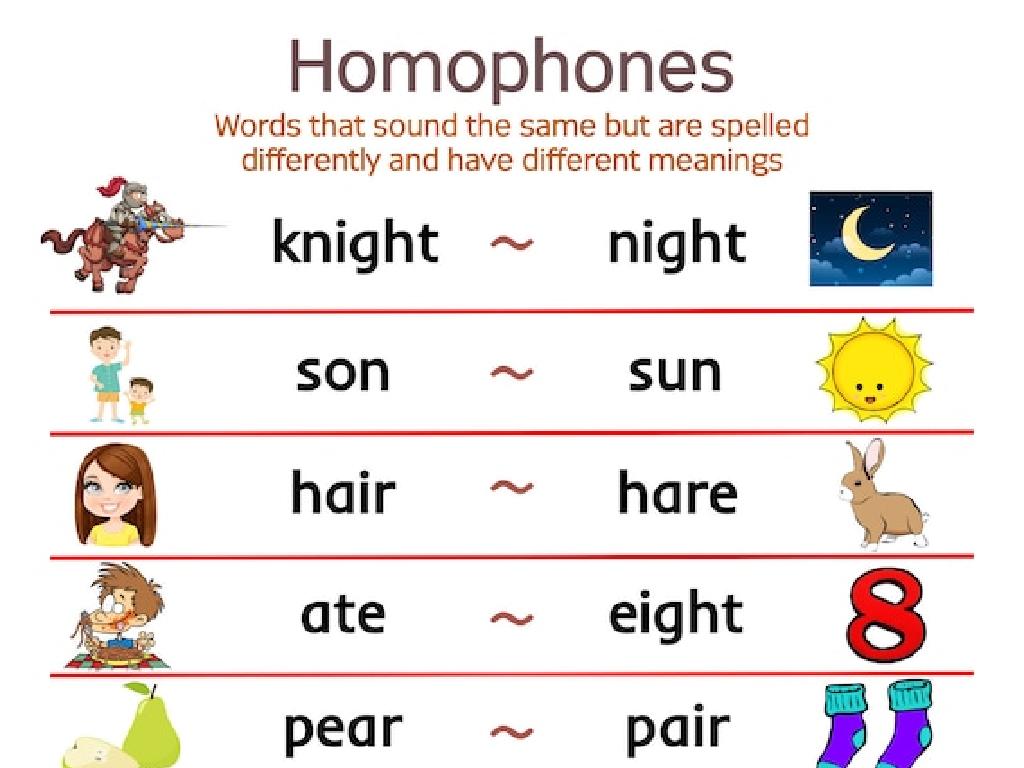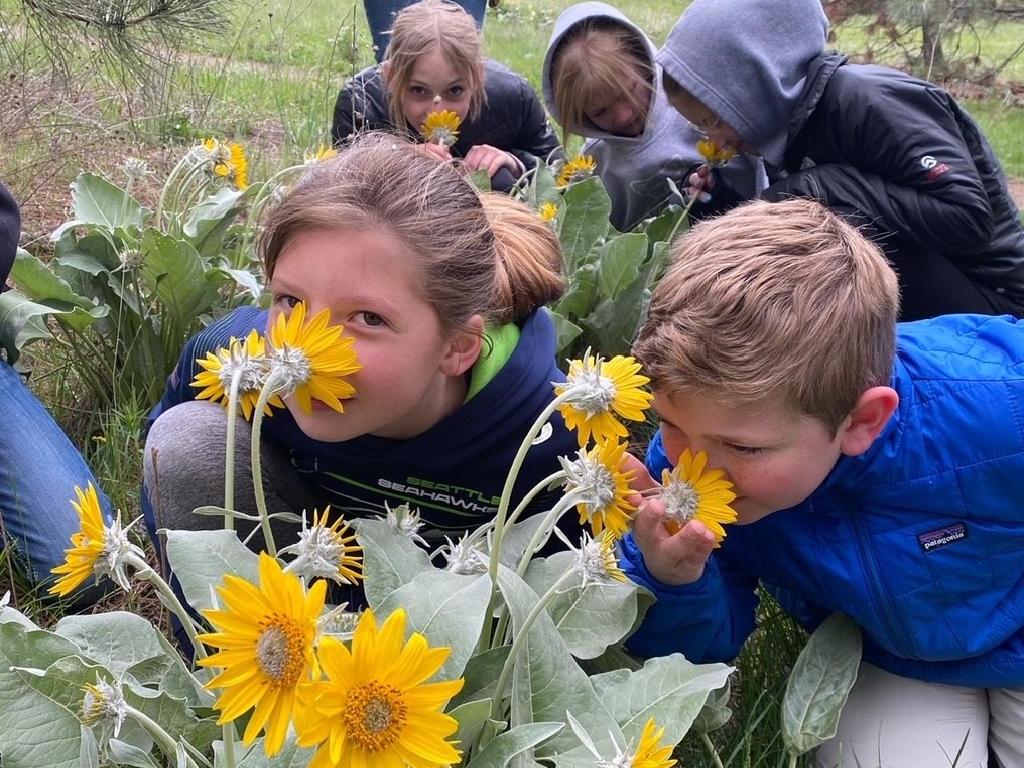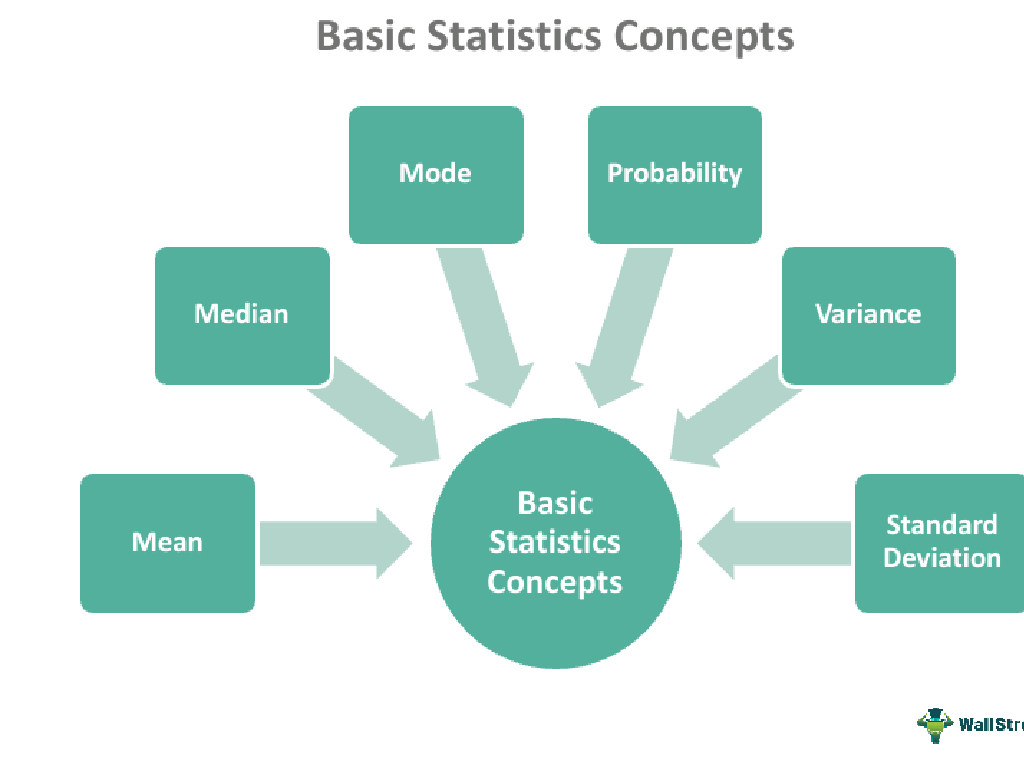Which Sentence Uses An Antonym?
Subject: Language arts
Grade: Fourth grade
Topic: Synonyms And Antonyms
Please LOG IN to download the presentation. Access is available to registered users only.
View More Content
Exploring Synonyms and Antonyms
– What are synonyms and antonyms?
– Synonyms are words with similar meanings, like ‘happy’ and ‘joyful’.
– Examples of synonyms
– ‘Big’, ‘large’, and ‘huge’ all mean the same.
– Examples of antonyms
– Antonyms are words with opposite meanings, like ‘hot’ and ‘cold’.
– Using them to enhance writing
– They add variety and excitement to stories and essays.
|
Begin the lesson by defining synonyms and antonyms, ensuring students understand the concept of words having similar and opposite meanings. Provide clear examples that they can relate to, such as ‘happy’ and ‘joyful’ for synonyms, and ‘hot’ and ‘cold’ for antonyms. Discuss how using synonyms and antonyms can make their writing more vivid and engaging. Encourage them to think of their own examples and to use these tools to add depth to their stories or essays. The goal is to help them recognize and use synonyms and antonyms to improve their communication skills.
Exploring Synonyms
– Synonyms have similar meanings
– Examples: ‘happy’ and ‘joyful’
– Both words express happiness
– ‘Sad’ is to ‘unhappy’
– Both words express sadness
– Think of your own synonyms!
– Share synonyms you know with the class
|
This slide introduces the concept of synonyms to the students. Begin by explaining that synonyms are words that mean almost the same thing, making our language richer and more interesting. Use the examples provided to illustrate how synonyms work. ‘Happy’ and ‘joyful’ both describe a feeling of pleasure, while ‘sad’ and ‘unhappy’ both describe a feeling of sorrow. Encourage the students to actively participate by thinking of additional synonyms and sharing them with the class. This will help them understand the concept better and see how common synonyms are in their daily language. Make sure to acknowledge all contributions to foster a supportive learning environment.
Exploring Antonyms
– Antonyms: Words with opposite meanings
– Examples: ‘big’ vs ‘small’
– Opposites like ‘large’ and ‘tiny’
– Examples: ‘light’ vs ‘dark’
– Opposites like ‘bright’ and ‘dim’
– Let’s find more antonyms!
– Think of opposites like ‘hot’ and ‘cold’
|
This slide introduces the concept of antonyms to the students. Start by explaining that antonyms are words that have completely opposite meanings. Provide clear examples with words they are familiar with, such as ‘big’ and ‘small’, ‘light’ and ‘dark’. Encourage the class to actively participate by coming up with more examples of antonyms. This can be turned into a fun activity where students can pair up and list as many antonyms as they can think of. This exercise will help them understand the concept of antonyms and how they are used in language to convey contrasting ideas.
Spotting Synonyms and Antonyms
– Understanding synonyms and antonyms
– Synonyms are words with similar meanings, antonyms are opposites
– Using context to find relationships
– Clues in sentences help us figure out if words are synonyms or antonyms
– Practice with the word ‘quick’
– Find a synonym and an antonym for ‘quick’
– Class activity: Antonym hunt
– Find sentences in your book that use an antonym for ‘quick’
|
This slide is aimed at helping fourth-grade students understand the concept of synonyms and antonyms. Begin by explaining that synonyms are words that mean the same thing, like ‘fast’ and ‘quick’, while antonyms are words with opposite meanings, like ‘quick’ and ‘slow’. Teach students to use context clues within a sentence to determine whether words are synonyms or antonyms. For practice, ask students to find a synonym and an antonym for the word ‘quick’. As a class activity, have students search for sentences in their reading books that use an antonym for ‘quick’ and share with the class. This will help reinforce their understanding of how antonyms work in language.
Exploring Antonyms in Sentences
– Understanding sentences for antonyms
– Look at how words in a sentence are opposite
– Example: Sun is bright, cave is dark
– ‘Bright’ and ‘dark’ are opposites, showing contrast
– Activity: Find the antonym
– Choose a sentence and spot the opposite words
|
This slide aims to teach students how to identify antonyms within the context of a sentence. Begin by explaining that antonyms are words with opposite meanings. Use the example provided to illustrate how contrasting ideas are presented in a sentence. For the activity, encourage students to find sentences in their books or come up with their own and identify the antonyms. This exercise will help them understand how antonyms can change the meaning of a sentence and enhance their vocabulary. Make sure to provide guidance on sentence structure and the importance of context in determining the meaning of words.
Let’s Practice Together: Synonyms and Antonyms!
– Class activity: Circle synonyms and antonyms
– Find words that mean the same (synonyms) or opposite (antonyms) in sentences.
– Work in pairs for collaboration
– Two heads are better than one! Help each other understand the words.
– Share findings with the class
– Discuss what you’ve learned with your classmates.
|
This slide introduces a class activity focused on identifying synonyms and antonyms within sentences. Students will work in pairs to encourage teamwork and discussion. They will look for words in sentences that have the same meaning (synonyms) or opposite meaning (antonyms) and circle them. After completing the activity, pairs will share their findings with the class, fostering a collaborative learning environment. For the teacher: Prepare sentences with clear examples of synonyms and antonyms beforehand. Consider grouping students with varying abilities to promote peer learning. Have a list of additional sentences ready for early finishers or as a challenge. Possible activities: 1) Matching games with synonyms and antonyms. 2) Creating sentences using a list of given synonyms and antonyms. 3) Drawing pictures to illustrate the meaning of synonyms and antonyms. 4) Writing a short story using a set of synonyms and antonyms.
Game Time: Synonym and Antonym Match-up!
– Interactive matching game
– Learn with synonyms and antonyms
– Find pairs of words that mean the same or opposite
– Why games make learning fun
– Games help remember words better because they’re fun
– Get ready to play and learn!
|
This slide introduces an interactive classroom activity designed to help students learn and differentiate between synonyms and antonyms through a matching game. The game will involve students finding pairs of words that are either synonyms (words that mean the same thing) or antonyms (words that mean the opposite). Explain to the students how using games in learning can make the experience more enjoyable and memorable. Before starting the game, ensure that students understand the rules and the objective. Provide examples of synonym and antonym pairs to guide them. For the activity, prepare a set of word cards in advance, with each card containing a word that has a corresponding synonym or antonym in the set. During the next class, students will match these cards in pairs. This exercise will reinforce their understanding of the concept of synonyms and antonyms in a fun and engaging way.
Class Activity: Crafting Sentences with Antonyms
– Write sentences using antonyms
– Example: ‘The giant’s steps were thunderous, but the mouse’s steps were silent.’
– ‘Thunderous’ and ‘silent’ are opposites, showing contrast in noise level
– Share your sentences with a partner
– Discuss the antonyms used
– Talk about why the words you chose are antonyms
|
This activity is designed to help students understand and use antonyms effectively. Start by explaining that antonyms are words with opposite meanings. Provide the example sentence to illustrate how antonyms can be used to create a vivid contrast in a sentence. Encourage students to use their creativity to come up with their own sentences that include antonyms. After writing, students should pair up to share their sentences and discuss the antonyms they’ve chosen. This peer interaction will reinforce their understanding of antonyms and how they can be used in language. As a teacher, walk around the classroom to assist and listen to the discussions, providing guidance and feedback where necessary. Possible variations of the activity could include drawing pictures to represent the antonyms, using antonyms to describe characters from a story, or even creating a short skit using sentences with antonyms.
Wrapping Up: Synonyms and Antonyms
– Review of synonyms and antonyms
– Synonyms are words that mean the same, antonyms are opposites
– Reflect on today’s learning
– Homework: 5 pairs of synonyms and antonyms
– Find and write 5 pairs like ‘happy’ and ‘joyful’ for synonyms, ‘hot’ and ‘cold’ for antonyms
– Share your work next class
– Be ready to present your pairs and how you found them
|
As we conclude today’s lesson on synonyms and antonyms, recap the definitions and examples discussed in class. Ask students how they felt about the lesson to gauge their understanding. For homework, they should write down 5 pairs of synonyms and 5 pairs of antonyms, which will help reinforce their understanding of the concept. Encourage creativity in their choices and remind them that they will be sharing their findings in the next class, promoting accountability and the opportunity to learn from each other. Provide guidance on how to use a thesaurus or dictionary if needed.






